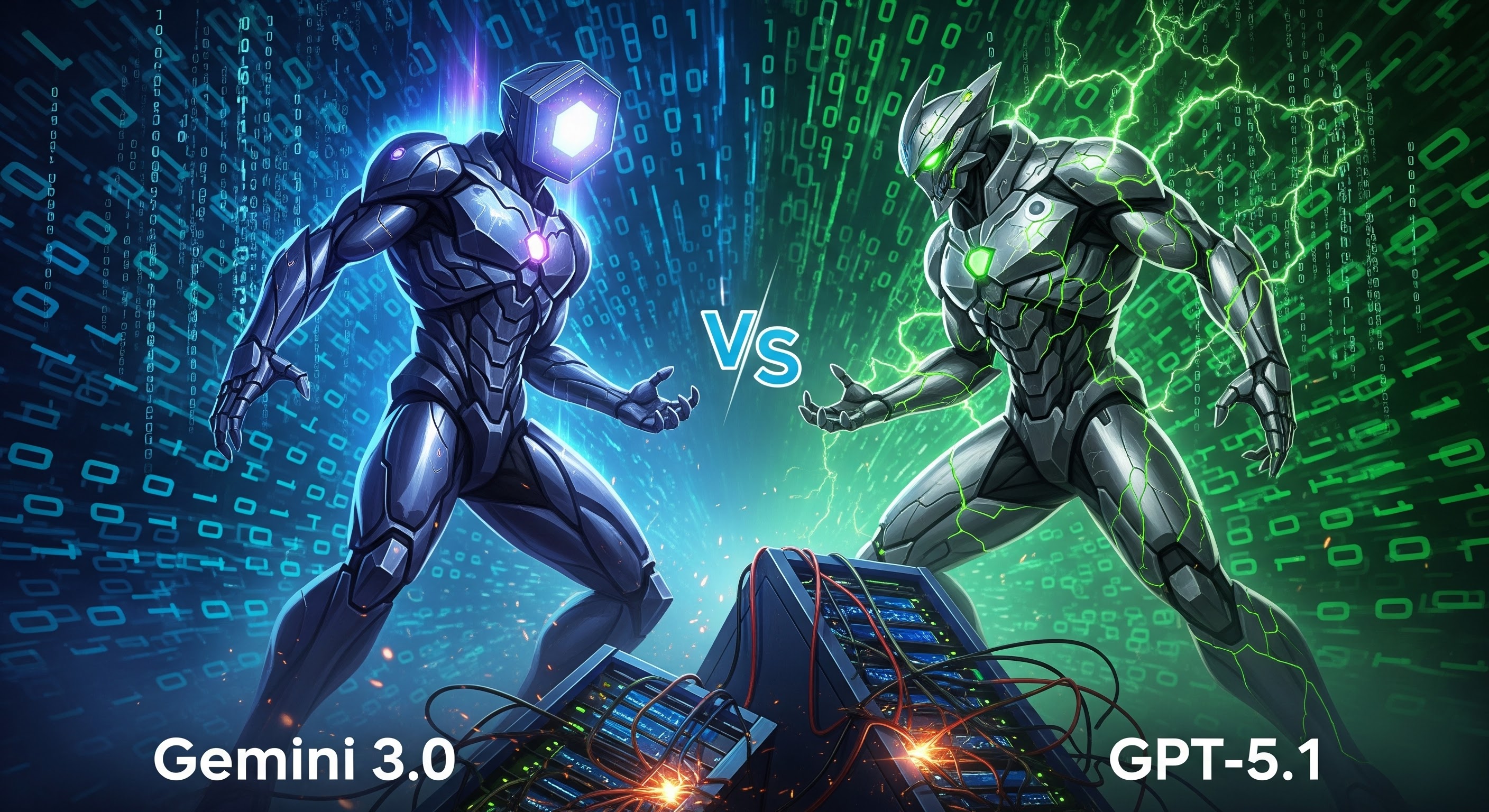
GPT-5.1 vs Gemini 3.0: analysis and comparison of the two 2025 flagships LLM models
The close release of GPT-5.1 and Gemini 3.0 opened a new phase of competition between OpenAI and Google. Beyond the technological dimension, these models now define major strategic directions for retailers and B2B marketing teams: workflow automation, creative production, optimization of Shopping campaigns, and integration into productive environments. This article analyzes these two models in depth by adopting a business prism: what are their real strengths, where are their limits, and above all, how to understand the dominance dynamic between Google and OpenAI when it comes to e-commerce.
The confrontation between GPT-5.1 and Gemini 3.0 illustrates a major evolution: AI no longer advances only through technological breakthroughs, but through ecosystem strategies. Both models embody distinct visions of the role of AI in work, software, and business decisions. This analysis offers a structured reading of their strengths, limitations and implications for businesses.
1. Two launches revealing a platform battle
1.1 GPT-5.1: a rapid iteration strategy
GPT-5.1 is presented as an optimization rather than a deep-tech architectural change. The objective is to correct the limitations perceived in the previous version: high latency, too cold tone, instability in certain reasoning.
The logic is centered on three improvements:
- Significantly reduced response time on simple questions.
- Adaptive reasoning that automatically adjusts resources.
- Better conversational fluidity for daily uses.
This approach illustrates an assumed positioning: strengthening the user experience to consolidate dominance in the consumer market, while improving reliability for product teams and developers.
1.2 Gemini 3.0: broad integration from day one
In contrast, Gemini 3.0 adopts a massive and immediate integration strategy. The model is directly deployed in Search, Workspace, Android, Vertex AI, and Google developer tools. The approach aims to place AI at the heart of an infrastructure that is already omnipresent in organizations.
This choice highlights:
- Native multimodal understanding (text, image, video, audio).
- A superior depth of reasoning, designed for complex tasks.
- Seamless integration into collaborative environments.
Two approaches are emerging: on the one hand a generative conversational platform, on the other hand, a systemic AI that is part of the entire Google ecosystem.
2. Technical innovations: what each model changes
2.1 GPT-5.1 and adaptive reasoning
The central innovation, adaptive reasoning, allows the model to automatically modulate the computational effort according to the complexity of the prompt. This results in:
- Almost instant answers for simple queries.
- Higher computational effort for demanding tasks.
- A decrease in “token waste” and a gain in precision.
For technical teams, this feature reduces iteration time and improves productivity in environments where latency plays a key role.
2.2 Gemini 3.0 and native multimodality
Gemini 3.0 is based on a unified architecture, designed from the start to process text, images, video, and audio simultaneously. Unlike models enriched by successive modules, this native approach guarantees greater coherence between the various media.
Examples observed:
- More accurate reading of complex screenshots.
- An ability to analyze long and varied video sequences.
- A structured extraction of information in heterogeneous documents.
This multimodal mastery opens the way to agents capable of operating directly in visual environments, an essential skill to replace traditional automations.
3. Benchmarks: a net technical advantage for Gemini 3.0
3.1 Depth of reasoning
On the tests most famous for their difficulty, Gemini 3.0 shows a significant lead, especially in:
- Abstract reasoning.
- Multi-stage logic.
- Tasks that require in-depth conceptual analysis.
The differences observed confirm a better modeling of complex thought chains, which are essential in fields such as research, legal or strategy.
3.2 Visual and multimodal intelligence
The ability to interpret interfaces and visual environments is one of the most structuring differences.
Gemini 3.0 surpasses GPT-5.1 on:
- The identification of buried interface elements.
- Understanding dashboards, UIs or web apps.
- Virtual navigation to execute workflows.
This advantage opens the door to agents capable of controlling software, reading visual data and triggering actions independently.
3.3 Mathematics and coding
The data shows:
- GPT-5.1 solid in debugging and producing consistent code.
- Gemini 3.0 more efficient in advanced mathematics.
- Nearly parity in real software engineering benchmarks.
The use therefore depends more on the use case than on an absolute advantage.
4. Market adoption, perception and dynamics
4.1 Mixed reception for GPT-5.1
Despite improvements in fluidity, some advanced users note:
- Stricter content filtering.
- A tone that is still considered less warm than previous versions.
- Difficulty accessing previous models.
These returns highlight a persistent tension: reconciling security requirements and freedom of use for developers.
4.2 A very favorable reception for Gemini 3.0
In technical communities, Gemini 3.0 is enjoying a positive reception thanks to:
- Stable performance on complex tasks.
- The ability to produce entire projects in a timely manner.
- Direct integration with tools already used in organizations.
The consistency of the results reinforces the confidence of the technical teams.
4.3 Two opposing market dynamics
Competition is expressed in two areas:
- In the consumer market, GPT remains the reference thanks to its massive user base.
- In multimodal uses and business workflows, Google is gaining ground.
Organizations are now tending towards multi-model strategies to cover as many use cases as possible.
5. Strategic challenges for businesses
5.1 When should GPT-5.1 be preferred
GPT-5.1 is particularly suitable when:
- Conversational quality is a priority.
- Uses require a controlled tone.
- The speed of execution on simple tasks is critical.
- Costs need to be optimized.
GPT-5.1 therefore remains a consistent choice for internal assistants, chatbots, and tools that require fluid interaction.
5.2 When should Gemini 3.0 be preferred
Gemini 3.0 is more relevant for:
- Complex multimodal tasks.
- The analysis of long and varied contexts.
- Software control via visual agents.
- Scientific or strategic work requiring profound reasoning.
Businesses that are already integrated into Google Cloud benefit from an obvious synergy effect.
5.3 The emergence of a hybrid strategy
Many organizations are now opting for an architecture that combines multiple models. This approach allows:
- To reduce the risks of dependence on a single supplier.
- To optimize costs by routing each request to the most suitable model.
- To improve the resilience of systems.
- To take advantage of the respective strengths of the models.
The challenge then becomes the establishment of a level of abstraction allowing intelligent routing.
6. Perspectives: towards a unified agent layer
GPT-5.1 and Gemini 3.0 converge on the same objective: to become the engine of the agent layer capable of orchestrating actions, interacting with software and managing multimodal environments. The challenge goes beyond simply comparing performance.
Three dimensions structure this race:
- Control of the environment (browser, search, cloud, mobile).
- Multimodal activation (text, image, video, interface).
- Integration into business tools.
GPT-5.1 relies on the platform.
Gemini 3.0 builds on Google's infrastructure.
Two complementary visions, but profoundly different in their implementation.
Conclusion
The face-to-face between Gemini 3.0 and ChatGPT 5.1 does not designate a single winner: it reveals two approaches that respond to different but complementary logics. On the one hand, Google is pushing for a deeper, more multimodal and more autonomous AI, capable of analyzing complex environments and reasoning over long chains. On the other hand, OpenAI favors fluidity, speed and a more accessible user experience, which remains a decisive asset for daily uses.
Benchmarks confirm Gemini's technical advantage on the most demanding tasks, while ChatGPT maintains a notable superiority in natural interactions. In a context where the market is fragmenting and where companies are increasingly adopting multi-model strategies, the real challenge is no longer to decide between two models, but to make sure to use the one that really corresponds to each business need.
This is precisely the approach proposed by the Dataïads e-commerce optimization platform. Through an approach multimodel and multimodal, Dataïads makes it possible to exploit the best models on the market according to the uses: product analysis, flow enrichment, advertising visual generation and multimodal marketing assets. Gemini 3.0 is now available on the Dataïads platform, offering a new depth of analysis, multi-modal capacity and performance to e-commerce teams.
To learn how to enable these models in your product and advertising workflows, you can request a personalized demo.
Continue reading

GPT-5.1 vs Gemini 3.0: analysis and comparison of the two 2025 flagships LLM models

SEO vs GEO: understanding a major change for e-commerce

Black Friday 2025: the compliance guide for your Google Shopping and Meta Catalog Ads campaigns
.svg)







